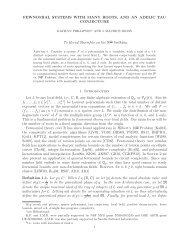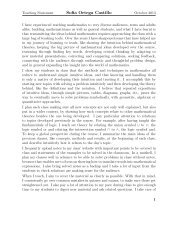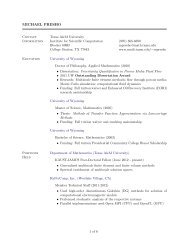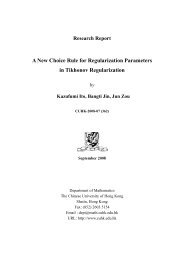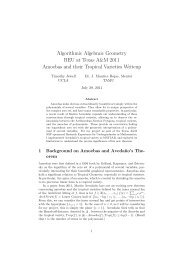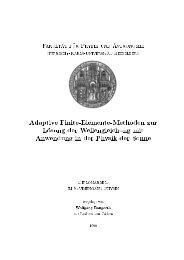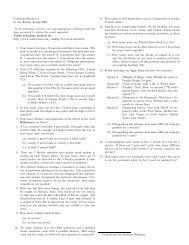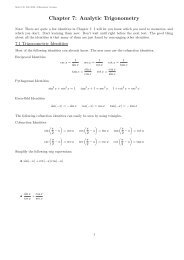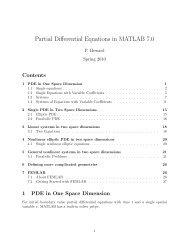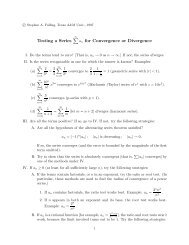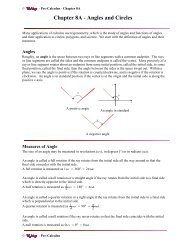Solutions for homework assignment #5
Solutions for homework assignment #5
Solutions for homework assignment #5
Create successful ePaper yourself
Turn your PDF publications into a flip-book with our unique Google optimized e-Paper software.
<strong>Solutions</strong> <strong>for</strong><br />
<strong>homework</strong> <strong>assignment</strong> <strong>#5</strong><br />
Problem 1. Consider the non-Sturm-Liouville differential equation<br />
d2φ + α(x)dφ + (λβ(x) + γ(x))φ = 0.<br />
dx2 dx<br />
Multiply this equation by H(x). Determine H(x) such that the equation may be reduced to<br />
the standard Sturm-Liouville <strong>for</strong>m:<br />
<br />
d<br />
p(x)<br />
dx<br />
dφ<br />
<br />
+ (λσ(x) + q(x))φ = 0.<br />
dx<br />
Given α(x), β(x), and γ(x), what are p(x), σ(x), and q(x)?<br />
Solution: p(x) = e A(x) , σ(x) = e A(x) β(x), and q(x) = e A(x) γ(x), where A is an anti-derivative<br />
of α.<br />
Detailed solution: The standard Sturm-Liouville equation can be rewritten as<br />
p(x)φ ′′ (x) + p ′ (x)φ ′ (x) + (λσ(x) + q(x))φ = 0<br />
(assuming p is differentiable). This is to be the same as the equation<br />
H(x)φ ′′ (x) + H(x)α(x)φ ′ (x) + (λH(x)β(x) + H(x)γ(x))φ(x) = 0.<br />
It follows that p = H, p ′ = Hα, σ = Hβ, and q = Hγ. We expect H to be positive. Then the first<br />
two relations imply that<br />
p ′<br />
<br />
<br />
= α =⇒ log p = α(x)dx =⇒ p = exp<br />
p <br />
α(x)dx .<br />
Consequently, σ = pβ and q = pγ.<br />
Problem 2. Consider<br />
cρ ∂u<br />
∂t<br />
<br />
∂<br />
=<br />
∂x<br />
where c,ρ,K0,α are functions of x, subject to<br />
K0<br />
<br />
∂u<br />
+ αu,<br />
∂x<br />
u(0,t) = u(L,t) = 0, u(x, 0) = f(x).<br />
Assume that the appropriate eigenfunctions are known.<br />
(i) Show that the eigenvalues are positive if α < 0.<br />
(ii) Solve the initial value problem.<br />
(iii) Briefly discuss lim<br />
t→+∞ u(x,t).<br />
Solution:<br />
u(x, t) = ∞<br />
n=1 cne −λn φn(x),<br />
where λ1 < λ2 < . . . are eigenvalues of the Sturm-Liouville eigenvalue problem<br />
(K0φ ′ ) ′ + αφ + λcρφ = 0, φ(0) = φ(L) = 0,<br />
1
φ1, φ2, . . . are the corresponding eigenfunctions, and<br />
L<br />
f(x)φn(x)c(x)ρ(x)dx<br />
0<br />
cn = L<br />
|φn(x)| 2 .<br />
c(x)ρ(x)dx<br />
If λ1 > 0 then lim u(x, t) = 0.<br />
t→+∞<br />
0<br />
Detailed solution: We search <strong>for</strong> the solution of the initial-boundary value problem as a<br />
superposition of solutions u(x, t) = φ(x)G(t) with separated variables of the differential equation that<br />
satisfy the boundary conditions.<br />
Substituting u(x, t) = φ(x)G(t) into the differential equation, we obtain<br />
c(x)ρ(x)φ(x)G ′ (t) = (K0(x)φ ′ (x)) ′ G(t) + αφ(x)G(t),<br />
G ′ (t)<br />
G(t) = (K0(x)φ ′ (x)) ′ + αφ(x)<br />
c(x)ρ(x)φ(x)<br />
Since the left-hand side does not depend on x while the right-hand side does not depend on t, it follows<br />
that<br />
G ′ (t)<br />
G(t) = (K0(x)φ ′ (x)) ′ + αφ(x)<br />
= −λ,<br />
c(x)ρ(x)φ(x)<br />
where λ is a constant. Then<br />
G ′ = −λG, (K0φ ′ ) ′ + αφ + λcρφ = 0.<br />
Conversely, if functions G and φ are solutions of the above ODEs <strong>for</strong> the same value of λ, then<br />
u(x, t) = φ(x)G(t) is a solution of the given PDE.<br />
Substituting u(x, t) = φ(x)G(t) into the boundary conditions, we get<br />
φ(0)G(t) = 0, φ(L)G(t) = 0.<br />
It is no loss to assume that G is not identically zero. Then the boundary conditions are satisfied if<br />
and only if φ(0) = φ(L) = 0.<br />
To determine φ, we have a regular Sturm-Liouville eigenvalue problem<br />
(K0φ ′ ) ′ + αφ + λcρφ = 0, φ(0) = φ(L) = 0.<br />
This problem has infinitely many eigenvalues λ1 < λ2 < . . .. Let φn denote an eigenfunction corresponding<br />
to the eigenvalue λn. Then φn is determined up to multiplying by a scalar. λn and φn are<br />
related through the Rayleigh quotient<br />
−K0φnφ<br />
λn =<br />
′ n<br />
<br />
<br />
L<br />
0 +<br />
L<br />
0<br />
(K0|φ ′ n| 2 − α|φn| 2 )dx<br />
L<br />
cρ|φn| 2 dx<br />
0<br />
Since φn(0) = φn(L) = 0, the non-integral term vanishes. If α < 0 then it follows that λn > 0.<br />
The function G is to be determined from the equation G ′ = −λG. The general solution of this<br />
equation is G(t) = c0e −λt , where c0 is a constant.<br />
Thus we obtain the following solutions of the heat equation satisfying the boundary conditions:<br />
un(x, t) = e −λn φn(x), n = 1, 2, . . .<br />
2<br />
.<br />
.
A superposition of these solutions is a series<br />
u(x, t) = ∞<br />
n=1 cne −λn φn(x),<br />
where c1, c2, . . . are constants. Substituting the series into the initial condition u(x,0) = f(x), we get<br />
f(x) = ∞<br />
n=1 cnφn(x).<br />
Hence the initial condition is satisfied if cn are coefficients of the generalized Fourier series of f, that<br />
is, if<br />
L<br />
f(x)φn(x)c(x)ρ(x)dx<br />
0<br />
cn = L<br />
|φn(x)| 2 .<br />
c(x)ρ(x)dx<br />
0<br />
If all eigenvalues are positive then the solution u(x, t) vanishes as t → +∞ because each term of<br />
the corresponding series contains a decaying factor e −λn .<br />
Problem 3. A Sturm-Liouville problem is called self-adjoint if<br />
p (uv ′ − vu ′ )<br />
<strong>for</strong> any two functions u and v satisfying the boundary conditions. Show that the following yield<br />
self-adjoint problems:<br />
(i) φ ′ (0) = 0 and φ(L) = 0;<br />
(ii) φ ′ (0) − hφ(0) = 0 and φ ′ (L) = 0.<br />
Solution: (i) Suppose that functions u and v satisfy the boundary conditions u ′ (0) = v ′ (0) = 0<br />
and u(L) = v(L) = 0. The first condition implies that u(0)v ′ (0) − v(0)u ′ (0) = 0 while the second one<br />
implies that u(L)v ′ (L) − v(L)u ′ (L) = 0. It follows that<br />
p (uv ′ − vu ′ )<br />
(ii) Suppose that functions u and v satisfy the boundary conditions u ′ (0)−hu(0) = v ′ (0)−hv(0) = 0<br />
and u ′ (L) = v ′ (L) = 0. The first condition implies that u(0)v ′ (0) − v(0)u ′ (0) = u(0) · hv(0) − v(0) ·<br />
hu(0) = 0 while the second one implies that u(L)v ′ (L) − v(L)u ′ (L) = 0. It follows that<br />
p (uv ′ − vu ′ )<br />
<br />
<br />
<br />
<br />
b<br />
a<br />
L<br />
0<br />
<br />
<br />
L<br />
0<br />
= 0<br />
= 0.<br />
= 0.<br />
Problem 4. Consider the boundary value problem<br />
φ ′′ + λφ = 0 with φ(0) − φ ′ (0) = 0, φ(1) + φ ′ (1) = 0.<br />
(i) Using the Rayleigh quotient, show that λ ≥ 0. Why is λ > 0?<br />
(ii) Show that<br />
tan √ λ = 2√ λ<br />
λ − 1 .<br />
Determine the eigenvalues graphically. Estimate the large eigenvalues.<br />
3
Solution: √ λn ∼ (n − 1)π as n → ∞.<br />
Detailed solution: (i) The Rayleigh quotient relates an eigenfunction φ to the corresponding<br />
eigenvalue λ:<br />
<br />
<br />
1<br />
The boundary conditions imply that<br />
−φφ ′<br />
λ =<br />
−φφ ′<br />
1<br />
0 +<br />
1<br />
0<br />
0<br />
|φ(x)| 2 dx<br />
|φ ′ (x)| 2 dx<br />
<br />
<br />
1<br />
0 = −φ(1)φ′ (1) + φ(0)φ ′ (0) = |φ(1)| 2 + |φ(0)| 2 ≥ 0.<br />
It follows that λ ≥ 0. Furthermore, if λ = 0 then φ(0) = φ(1) = 0 and φ ′ is identically zero, which is<br />
not possible since then φ is also identically zero. Thus λ > 0.<br />
(ii) For any λ > 0 the general solution of the equation φ ′′ + λφ = 0 is φ(x) = c1 cos µx + c2 sinµx,<br />
where µ = √ λ and c1, c2 are constants. Substituting this into the boundary conditions φ(0) = φ ′ (0)<br />
and φ(1) = −φ ′ (1), we obtain<br />
It follows that<br />
c1 = c2µ, c1 cos µ + c2 sin µ = c1µsin µ − c2µcos µ.<br />
c2(µcos µ + sinµ) = c2(µ 2 sinµ − µcos µ),<br />
c2((µ 2 − 1)sin µ − 2µcos µ) = 0.<br />
A nonzero solution of the boundary value problem exists if and only if (µ 2 − 1)sin µ = 2µcos µ. Since<br />
cos 1 = 0, the latter equality implies that µ 2 = 1 and cosµ = 0. Hence it is equivalent to<br />
It remains to recall that µ = √ λ.<br />
1<br />
1 π<br />
2<br />
2µ<br />
µ 2 −1<br />
tan µ = 2µ<br />
µ 2 − 1 .<br />
tan µ<br />
4<br />
3π<br />
2<br />
.<br />
µ
Let 0 < λ1 < λ2 < ... be the eigenvalues. Graphically, we establish that 1 < √ λ1 < π/2,<br />
π/2 < √ λ2 < 3π/2, and (2n − 3)π/2 < √ λn < (2n − 1)π/2 <strong>for</strong> n = 3, 4,.... Moreover,<br />
√ λn ≈ (n − 1)π <strong>for</strong> a large n.<br />
Problem 5. Consider the eigenvalue problem<br />
φ ′′ + λφ = 0 with φ(0) = φ ′ (0) and φ(1) = βφ ′ (1).<br />
For what values (if any) of β is λ = 0 an eigenvalue?<br />
Solution: β = 2.<br />
Detailed solution: In the case λ = 0, the general solution of the equation φ ′′ + λφ = 0<br />
is a linear function φ(x) = c1 + c2x, where c1, c2 are constants. Substituting it into the boundary<br />
conditions φ(0) = φ ′ (0) and φ(1) = βφ ′ (1), we obtain equalities c1 = c2, c1 + c2 = βc2. They imply<br />
that 2c1 = 2c2 = βc2. If β = 2, it follows that c1 = c2 = 0, hence there are no eigenfunctions with<br />
eigenvalue λ = 0. If β = 2 then φ(x) = 1 + x is indeed an eigenfunction.<br />
5



